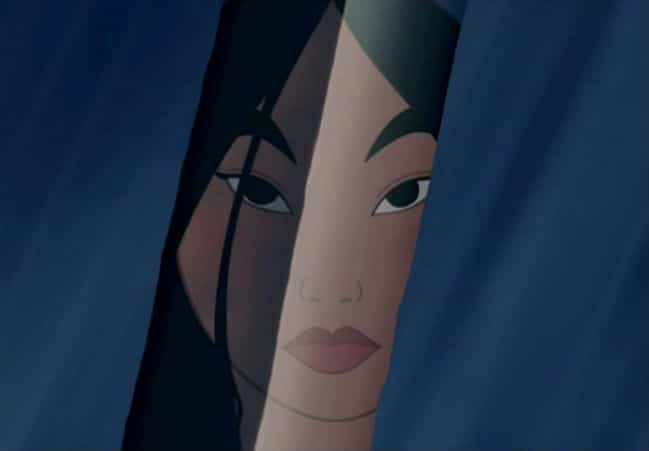
Welcome to Revisiting Disney! This week, we’re looking at that one Disney movie with a song you just can’t help but sing along with, Mulan! Like always, I have labeled each category so if you want to skip to the parts that interest you most, feel free. And, of course, if you have any thoughts, burning or otherwise, please share in the comments!
BACKGROUND OF MULAN
Released on June 19th, 1998, Mulan is another in a recent long line of films with strong and determined female leads. Mulan herself is a powerhouse; willing to sacrifice her life for her family and country, and throwing herself into a world that is very foreign to her. Mulan is unique because it is the first Disney movie to be released on DVD (November 1999), and also dealt very openly with the issue of warfare (something that we typically don’t see in Disney films). Mulan also is the first Disney movie with an Asian heroine, and was almost rated PG because it uses the term “cross-dresser.”
Originally, the production team had wanted to make a very different story, with a Mulan who was unhappy in her life. However, they felt that this made Mulan’s journey more about escaping the life she was trapped in. Her motivation then became more about her own happiness (not that that’s a bad thing, but the production team said that she was just unlikable).
They realized that they were doing a disservice to the source material and robbing the character of her true motivation as they saw it, doing the right thing as best as she could. As a result, they went back to the drawing board, making Mulan more human, but also more determined to do what is right, just because it is.
MUSIC
Two songs from Mulan stick out after watching it. The first is “Reflection,” which was nominated for a Golden Globe in 1999. “Reflection” was performed in the film by Lea Salonga, who also served as the singing voice of Princess Jasmine in Aladdin (and a Broadway veteran). There was also a “pop version” of the song, performed by Christina Aguilera in her US debut. Both are fun to sing along with, and both were very likely to be an anthem for the shy, nerdy type.
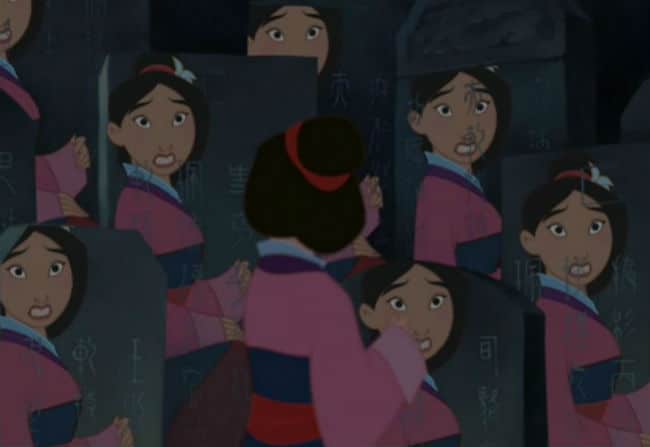
Other songs of note include “True to Your Heart” performed by pop sensation 98 Degrees, with Stevie Wonder. This, along with Christina Aguilera’s additional recording of “Reflection,” gave the music of Mulan some additional (and more obvious) star power.
Of course, the song we all know and are compelled to sing along with is “I’ll Make a Man Out of You,” sung by the talented Donny Osmond. It’s a delightfully upbeat training montage.
Really, this song and “Reflection” are great examples of the musical style of Mulan. It’s epic but silly. Serious at times, but can still have fun. The story knows how to break up the heavy aspects of the plot, and the music definitely helps with that.
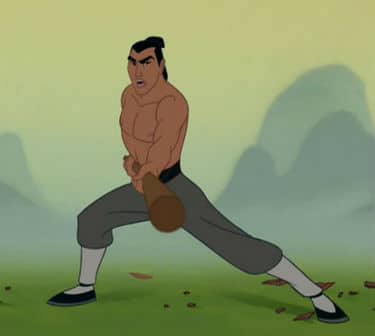
The songs were written by Matthew Wilder (music, who also worked on Pretty Woman) and David Zippel (lyrics, who we discussed last week with Hercules), with Jerry Goldsmith (who also worked on the music for “Star Trek: The Next Generation,” “Star Trek: Voyager,” and “The Waltons”). The Score was nominated for a 1999 Golden Globe, and the entire film was nominated for Best Music, Original Musical or Comedy Score at the 1999 Academy Awards.
ANIMATION
Mulan takes advantage of the computer technology that we’ve seen an increase in during the production of the last few films. This was mostly seen in the crowd scenes and the scenes with the Hun army. A computer program called “Atilla” was used to make this work when it came to the Hun army, and it’s similar to the way that the wildebeest stampede in The Lion King was done. The animators were able to replicate the characters but also add details and use different camera angles.
The crew also went to China for three weeks, to gain ideas for the landscape and the overall feel of how the movie should look. Some say they weren’t successful in that, but the animation does look lovely and the backgrounds are stunning.
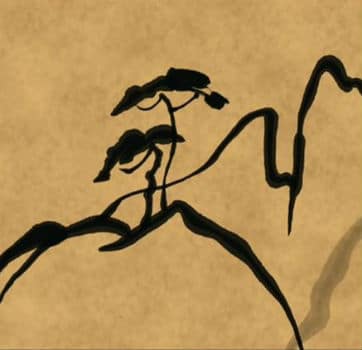
I also read that the opening scene was made with watercolors and rice paper. I’m not sure if that’s 100% accurate, but it does look cool and fits the overall theme that the studio is trying to go for. And honestly, it’s a fun story either way.
PLOT
Mulan opens with the invasion of China by the Hun Army, lead by the horrifyingly scary Shan-Yu , who took the construction of the Great Wall of China as a challenge (you know, like you do). When word reaches the Emperor of this invasion, he sends out his main army to defend his citizens. He also sets in motion the creation of a reserve army, needing one man from every family, saying that one man could be the difference between victory and defeat.
Our heroine’s family has only one man, her father who was wounded in a previous battle. Meanwhile, Mulan is struggling with her role in society. She’s feeling as though she is constantly hiding her true identity from the world, that of a woman who has her own opinions in a time when it was not accepted for a woman to have those.
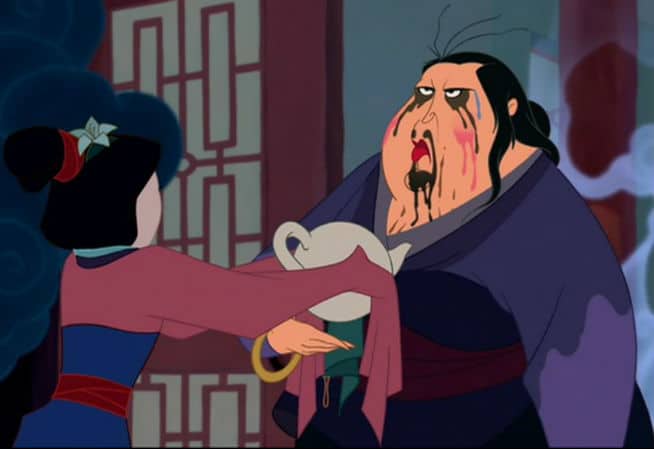
After a visit to the local matchmaker ends horribly, Mulan is horrified that she has brought dishonor to her family. Although her father reminds her that she might just be a late bloomer, she causes more trouble when she objects to her father’s conscription in front of a group of men, even arguing with one of them!
Unable to convince her father to stay home, she sees him limping and observes the pain it causes her mother to imagine him dying in battle. Mulan then makes the courageous choice to disguise herself as a man and join the army in his place. When they realize that she is gone, her family also realizes that they can’t go after her (she’ll be executed if the authorities catch her), but they pray for her safety.
This wakes up the ancestors, who decide to send the most powerful of the family guardians after her. However, since the most powerful of the family guardians is the one who sent her, he doesn’t go. Instead, Mushu, who had been demoted to the gong-ringer, goes after Mulan, determined to win his place as a guardian back by making Mulan a war hero.
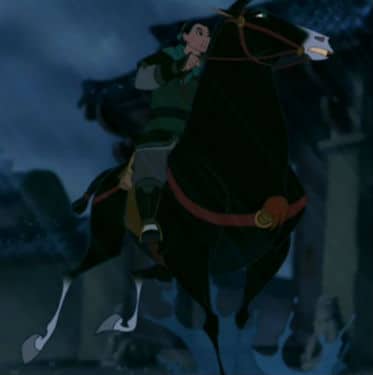
Mulan is grateful for Mushu’s help because she doesn’t know much about being a man. Mushu is pretty bad at it as well, and the combined failure of the two of them trying to fashion Mulan into a convincing man is some of the funniest stuff in the movie. As Mulan tries to not alienate her fellow soldiers, her captain Li Shang, who is on his first big assignment, tries to fashion his troops into a fighting force.
After some failure, Mulan proves herself to her captain and fellow soldiers. Inspired by her success, the troop becomes a force to be reckoned with. Mulan is almost discovered to be a woman several times during the movie, and this is also quite hilarious to watch. Her growing attraction to her commanding officer is an unexpected issue, as he also is starting to find himself attracted to her as well.
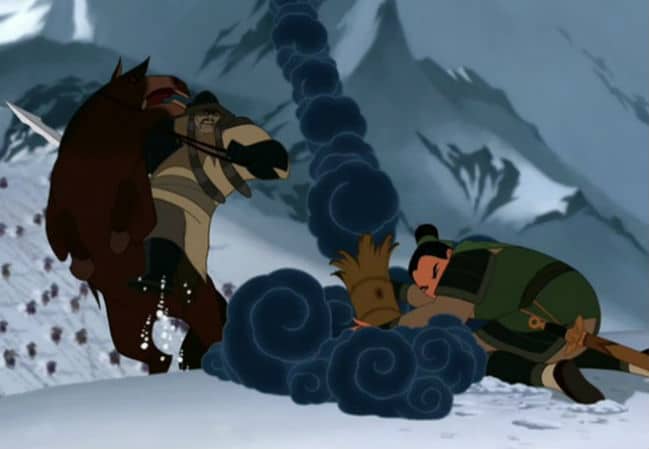
Although the member of the Emperor’s council, Chi Fu, who is with Shang and his troops threatens to make sure that the troops never see battle (and throws the fact that Shang’s father is the General at him), Mushu takes matters into his own hands. He and Cricket (who is believed to be lucky) forge a letter, telling the troops to head to the front.
When the troop heads to reinforce the army at the front lines, they find a massacre, the dead Chinese army, and the alive Hun army waiting in an ambush. This is additionally sad as Shang’s father was the general of the Chinese army, adding another layer of sadness to a very potent and heart-wrenching scene. It also means that this little rag-tag group of recruits is now the only standing army China has. No pressure guys.
When they find themselves under attack by the Hun army, Mulan’s quick outside-the-box thinking saves the day for China by wiping out the Huns with an avalanche. Shan-Yu gets a good look at her face before he’s buried, but that shouldn’t be an issue, right?
Sadly, Mulan is wounded in the battle and her secret is discovered. Chi Fu reminds everyone of the law; she must be put to death. However, Shang spares her life for saving his life, he leaves her in the mountains and tells her to go home. She, Mushu and Cricket have a heart to heart and tell each other the truth (Mushu wasn’t sent by her ancestors, she might have gone to war to prove herself, and Cricket is not lucky). Before they can head home, though, they see that part of the Hun army has survived and is headed for the capital.
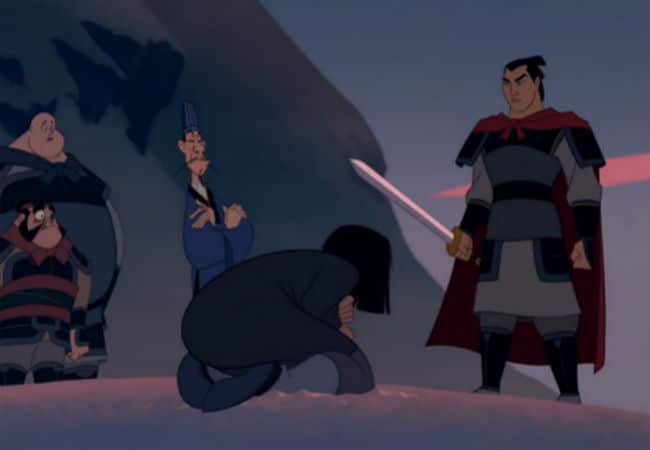
Realizing she has to warn Shang, Mulan risks further disgrace by riding into the capital as a woman and talking to a high-ranking military officer in public. Shang is still angry at her for her deceit, but when the Huns appear and kidnap the emperor, he and the rest of her friends are willing to listen to Mulan’s plan.
Sneaking into the palace where the emperor is being held, our heroes are able to save the emperor using their brains, not just physical strength. Although she could have escaped, when Shan-Yu is about to kill Shang, Mulan steps in and reveals that she was the one who set off the avalanche. This causes Shan-Yu to switch tactics, leaving Shang, and going after her.
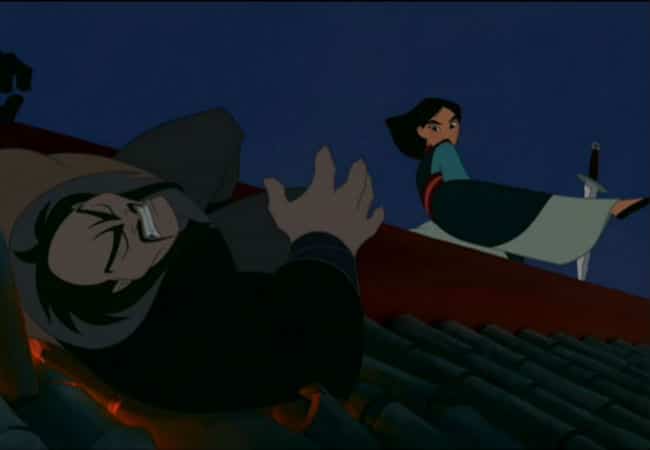
Using her brain and a series of unexpected moves, one of which involves a fan, Mulan is able to defeat Shan-Yu . The emperor is grateful, and after he bows to her (everyone else does too), he offers her a position on his council, though she turns it down to return home to her family. The emperor gives her tokens of his esteem, which also serves as proof that she has earned a high honor for service to the emperor.
Shang realizes that he may kind of really like Mulan, and with permission from the emperor goes to ask her father for her hand. First, however, Mulan returns home. When she gives her father the gifts that the emperor gave her family, her father tells her that having her as a daughter is an even higher honor than the rewards sent by the emperor.
Shang arrives and is adorably flustered by meeting Mulan’s father, the war hero, and by seeing Mulan there. Mulan saves him from the awkward situation, and it seems like everything is going to work out well for Mulan. She’s saved her father, saved China, saved the emperor, and fallen in love with a man who loves her for who she is inside. She’s also totally changed the way women are viewed in her society (well, in this world, at least). Not bad at all!
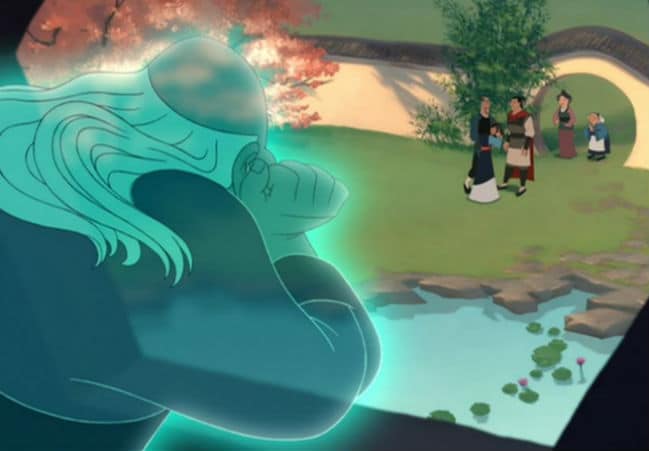
SOURCE MATERIAL
The movie Mulan is based on a Chinese legend about Hua Mulan, from a poem titled “The Ballad of Mulan.” The story follows a woman named Mulan who dressed as a man to serve in the army in place of her father. In the legend, however, Mulan goes to battle with the full support of her family to protect and save her father, as her younger brother is not old enough to go to war.
In every version of the story, Mulan is a war hero. In the original accounts, however, no one discovers her identity until she has left active service. In fact, in the poem, she serves for twelve years, does very well, is honored by the emperor, turns down a title, and goes home. Her fellow soldiers go to see her at her home and are shocked to learn that she is, in fact, a woman.
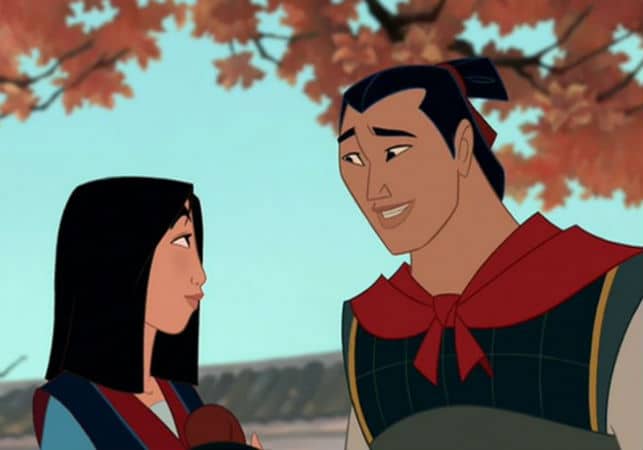
Was Mulan a real person? No one is really sure, but if she was, she probably lived during the Northern Wei dynasty, from 386 to %34 (CE or AD, whichever). There are also some versions of the poem where Mulan isn’t just offered a title; the emperor wants to marry one of his daughters to the brave soldier.
Even though the legend itself seems to have started in the 6th century AD, the story was expanded to the poem form sometime during the Ming Dynasty (1368 to 1644). Possibly this occurred later in the dynasty, but it is difficult to tell. The fact that the poem (and legend) focus heavily on gender issues (specifically equal rights), might be why the story is so popular and has lasted so long in popular culture.
The “Ballad of Mulan” is a poem well worth the read and available online. I’d encourage you to check it out (and if you can find an illustrated picture book, that’s even more fun).
The 1990’s
1998 was another year that can be seen as a very mixed year, as tends to just happen generally speaking. This was the year that both sides in Northern Ireland agree to a peace agreement, but it is also the year of the Bill Clinton/Monica Lewinsky scandal. There was a financial crisis in Southeast Asia and terror bombings in the US embassies in Nairobi and Dar es Salaam, with an earthquake in Afghanistan that killed over 5,000.
However, this year also saw the opening of the world’s biggest airport in Hong Kong and the Winter Olympics in Nagano, Japan (XVIII), which added in some new sports, including women’s hockey and snowboarding. Curling made a comeback, Tara Lipinski made Winter Olympic history, and Keiko, the star of Free Willy, was set to Iceland to be released someday.
These events are just the tip of the iceberg, as 1998 was a year of great change, both positive and negative. Mulan was, in a lot of ways, exactly the kind of movie that I remember wanting to see in 1998 because Mulan was a human character.
Like other people in the world at the time, Mulan was just trying to be the best she could be. She also showed that it was okay to be yourself. Like Tara Lipinski, the things that make us unique are special. We may not all be pro-skaters or able to go fight in the military, but that’s okay. The idea that it’s okay to be yourself, I think, was beginning to gain more traction in the late 1990s, and Mulan reflects that.
LESSONS LEARNED
The biggest lesson from Mulan is that it’s important to be yourself. Unique isn’t bad, and it’s our differences from others that allow us to truly make a difference in our world. Basically, find out who you are, be the best you you can be, and be happy. Don’t give up on yourself.
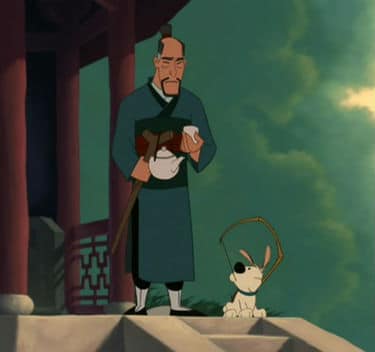
Another lesson is that just because someone is a late bloomer, that doesn’t mean that they aren’t worthwhile.
Thirdly, some things are worth risking everything for, and saving your family (and country, to some extent), is one of those things.
DOES IT HOLD UP?
Mulan is still one of my favorite Disney movies. The score is amazing, the songs are catchy, the characters are fun, and Mulan herself is wonderful. The lessons are still applicable, and the overall message never goes out of style. It’s a funny movie that also knows when to be serious, as it does deal with some serious subjects and includes war.
I’ve heard that Mulan is very much what Westerners think China is though I read an article that points out that the movie isn’t bad overall, it’s just an American movie that uses Chinese imagery and legends. The author lists the things that the Chinese did not appreciate about the film and then adds that it’s not really a film that’s trying to be accurate to Chinese culture, it just borrows some aspects.
Is this problematic? Yes, it is. I can see the argument here, and I get it. Personally, I thought that Mulan was obviously cartoony in a way that other films like Pocahontas and The Hunchback of Notre Dame were not. This made it to me, easier to forgive. Take that as you will, but I’d watch, research, and make your own decisions.
Photos: Disney
For next week: Tarzan
If you enjoyed this post and the others in the Revisiting Disney series, and have found yourself wishing that you could find them all in one convenient and bound book with eight extra essays, there is an option for you! Check out A Journey Through Disney: My Look Back Through Disney Canon, now available on Amazon as both a Kindle book ($4.99) and a paperback ($11.99).
OTHER SOURCES:
https://thewaltdisneycompany.com/about-disney/disney-history
http://www.imdb.com
http://studioservices.go.com/disneystudios/history.html
http://www.thepeoplehistory.com/1998.html
http://www.kidzworld.com/article/4255-1990s-timeline
http://ancientstandard.com/2011/06/17/the-real-story-of-mulan
http://www.huffingtonpost.com/quora/how-is-disneys-mulan-perc_b_4314035.html
Bailey, Adrian. Walt Disney’s World of Fantasy. Everest House Publishers. New York, New York. 1982.
Finch, Christopher. The Art of Walt Disney: From Mickey Mouse to the Magic Kingdom. Harry N. Abrams, Inc. New York, New York. 1975.
Johnston, Ollie and Frank Thomas. The Disney Villain. Hyperion. New York, New York. 1993.
Sale, Roger. Fairy Tales and After: From Snow White to E.B. White. Harvard University Press. Cambridge, MA, 1978.
Tatar, Maria. The Annotated Classic Fairy Tales. W.W. Norton and Company. New York and London, 2002.
Thomas, Bob. Disney’s Art of Animation From Mickey Mouse to Hercules. Hyperion. New York, New York. 1992.
Wright, Gordon. The Ordeal of Total War: 1939-1945. Harper Torchbooks, Harper & Row. New York, Hagerstown, San Francisco, and London, 1968.
ARE YOU A ROMANCE FAN? FOLLOW THE SILVER PETTICOAT REVIEW:
 Our romance-themed entertainment site is on a mission to help you find the best period dramas, romance movies, TV shows, and books. Other topics include Jane Austen, Classic Hollywood, TV Couples, Fairy Tales, Romantic Living, Romanticism, and more. We’re damsels not in distress fighting for the all-new optimistic Romantic Revolution. Join us and subscribe. For more information, see our About, Old-Fashioned Romance 101, Modern Romanticism 101, and Romantic Living 101.
Our romance-themed entertainment site is on a mission to help you find the best period dramas, romance movies, TV shows, and books. Other topics include Jane Austen, Classic Hollywood, TV Couples, Fairy Tales, Romantic Living, Romanticism, and more. We’re damsels not in distress fighting for the all-new optimistic Romantic Revolution. Join us and subscribe. For more information, see our About, Old-Fashioned Romance 101, Modern Romanticism 101, and Romantic Living 101.

Comments are closed.